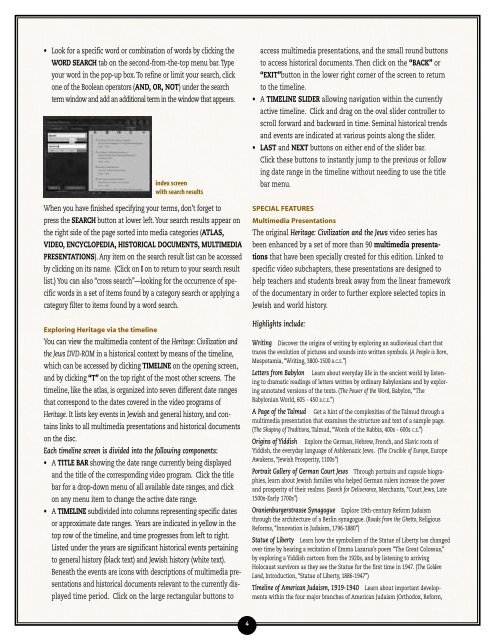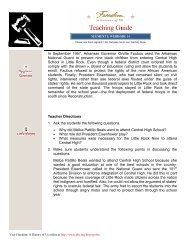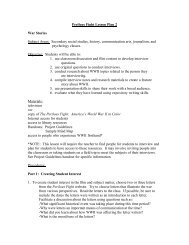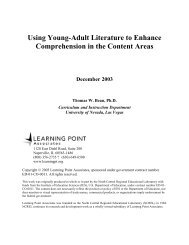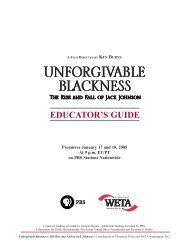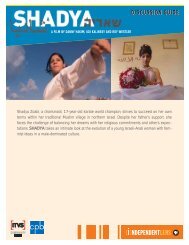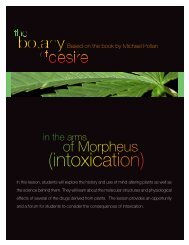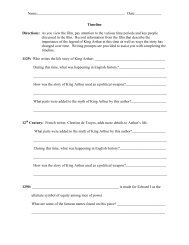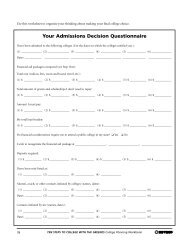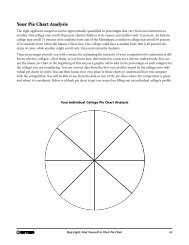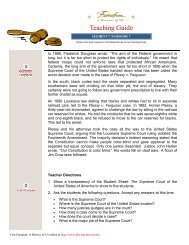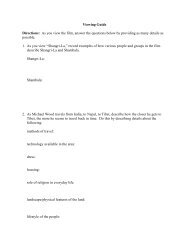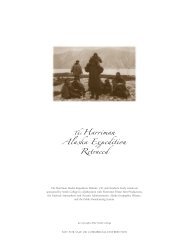HERITAGE: Civilization and the jews - PBS
HERITAGE: Civilization and the jews - PBS
HERITAGE: Civilization and the jews - PBS
Create successful ePaper yourself
Turn your PDF publications into a flip-book with our unique Google optimized e-Paper software.
• Look for a specific word or combination of words by clicking <strong>the</strong><br />
WORD SEARCH tab on <strong>the</strong> second-from-<strong>the</strong>-top menu bar. Type<br />
your word in <strong>the</strong> pop-up box. To refine or limit your search, click<br />
one of <strong>the</strong> Boolean operators (AND, OR, NOT) under <strong>the</strong> search<br />
term window <strong>and</strong> add an additional term in <strong>the</strong> window that appears.<br />
index screen<br />
with search results<br />
When you have finished specifying your terms, don’t forget to<br />
press <strong>the</strong> SEARCH button at lower left. Your search results appear on<br />
<strong>the</strong> right side of <strong>the</strong> page sorted into media categories (ATLAS,<br />
VIDEO, ENCYCLOPEDIA, HISTORICAL DOCUMENTS, MULTIMEDIA<br />
PRESENTATIONS). Any item on <strong>the</strong> search result list can be accessed<br />
by clicking on its name. (Click on I on to return to your search result<br />
list.) You can also “cross search”—looking for <strong>the</strong> occurrence of specific<br />
words in a set of items found by a category search or applying a<br />
category filter to items found by a word search.<br />
Exploring Heritage via <strong>the</strong> timeline<br />
You can view <strong>the</strong> multimedia content of <strong>the</strong> Heritage: <strong>Civilization</strong> <strong>and</strong><br />
<strong>the</strong> Jews DVD-ROM in a historical context by means of <strong>the</strong> timeline,<br />
which can be accessed by clicking TIMELINE on <strong>the</strong> opening screen,<br />
<strong>and</strong> by clicking “T” on <strong>the</strong> top right of <strong>the</strong> most o<strong>the</strong>r screens. The<br />
timeline, like <strong>the</strong> atlas, is organized into seven different date ranges<br />
that correspond to <strong>the</strong> dates covered in <strong>the</strong> video programs of<br />
Heritage. It lists key events in Jewish <strong>and</strong> general history, <strong>and</strong> contains<br />
links to all multimedia presentations <strong>and</strong> historical documents<br />
on <strong>the</strong> disc.<br />
Each timeline screen is divided into <strong>the</strong> following components:<br />
• A TITLE BAR showing <strong>the</strong> date range currently being displayed<br />
<strong>and</strong> <strong>the</strong> title of <strong>the</strong> corresponding video program. Click <strong>the</strong> title<br />
bar for a drop-down menu of all available date ranges, <strong>and</strong> click<br />
on any menu item to change <strong>the</strong> active date range.<br />
• A TIMELINE subdivided into columns representing specific dates<br />
or approximate date ranges. Years are indicated in yellow in <strong>the</strong><br />
top row of <strong>the</strong> timeline, <strong>and</strong> time progresses from left to right.<br />
Listed under <strong>the</strong> years are significant historical events pertaining<br />
to general history (black text) <strong>and</strong> Jewish history (white text).<br />
Beneath <strong>the</strong> events are icons with descriptions of multimedia presentations<br />
<strong>and</strong> historical documents relevant to <strong>the</strong> currently displayed<br />
time period. Click on <strong>the</strong> large rectangular buttons to<br />
access multimedia presentations, <strong>and</strong> <strong>the</strong> small round buttons<br />
to access historical documents. Then click on <strong>the</strong> “BACK” or<br />
“EXIT”button in <strong>the</strong> lower right corner of <strong>the</strong> screen to return<br />
to <strong>the</strong> timeline.<br />
• A TIMELINE SLIDER allowing navigation within <strong>the</strong> currently<br />
active timeline. Click <strong>and</strong> drag on <strong>the</strong> oval slider controller to<br />
scroll forward <strong>and</strong> backward in time. Seminal historical trends<br />
<strong>and</strong> events are indicated at various points along <strong>the</strong> slider.<br />
• LAST <strong>and</strong> NEXT buttons on ei<strong>the</strong>r end of <strong>the</strong> slider bar.<br />
Click <strong>the</strong>se buttons to instantly jump to <strong>the</strong> previous or follow<br />
ing date range in <strong>the</strong> timeline without needing to use <strong>the</strong> title<br />
bar menu.<br />
SPECIAL FEATURES<br />
Multimedia Presentations<br />
The original Heritage: <strong>Civilization</strong> <strong>and</strong> <strong>the</strong> Jews video series has<br />
been enhanced by a set of more than 90 multimedia presentations<br />
that have been specially created for this edition. Linked to<br />
specific video subchapters, <strong>the</strong>se presentations are designed to<br />
help teachers <strong>and</strong> students break away from <strong>the</strong> linear framework<br />
of <strong>the</strong> documentary in order to fur<strong>the</strong>r explore selected topics in<br />
Jewish <strong>and</strong> world history.<br />
Highlights include:<br />
Writing Discover <strong>the</strong> origins of writing by exploring an audiovisual chart that<br />
traces <strong>the</strong> evolution of pictures <strong>and</strong> sounds into written symbols. (A People is Born,<br />
Mespotamia, “Writing, 3800-1500 B.C.E.”)<br />
Letters from Babylon Learn about everyday life in <strong>the</strong> ancient world by listening<br />
to dramatic readings of letters written by ordinary Babylonians <strong>and</strong> by exploring<br />
annotated versions of <strong>the</strong> texts. (The Power of <strong>the</strong> Word, Babylon, “The<br />
Babylonian World, 605 - 450 B.C.E.”)<br />
A Page of <strong>the</strong> Talmud Get a hint of <strong>the</strong> complexities of <strong>the</strong> Talmud through a<br />
multimedia presentation that examines <strong>the</strong> structure <strong>and</strong> text of a sample page.<br />
(The Shaping of Traditions, Talmud, “Words of <strong>the</strong> Rabbis, 400s - 600s C.E.”)<br />
Origins of Yiddish Explore <strong>the</strong> German, Hebrew, French, <strong>and</strong> Slavic roots of<br />
Yiddish, <strong>the</strong> everyday language of Ashkenazic Jews. (The Crucible of Europe, Europe<br />
Awakens, “Jewish Prosperity, 1100s”)<br />
Portrait Gallery of German Court Jews Through portraits <strong>and</strong> capsule biographies,<br />
learn about Jewish families who helped German rulers increase <strong>the</strong> power<br />
<strong>and</strong> prosperity of <strong>the</strong>ir realms. (Search for Deliverance, Merchants, “Court Jews, Late<br />
1500s-Early 1700s”)<br />
Oranienburgerstrasse Synagogue Explore 19th-century Reform Judaism<br />
through <strong>the</strong> architecture of a Berlin synagogue. (Roads from <strong>the</strong> Ghetto, Religious<br />
Reforms, “Innovation in Judaism, 1796-1880”)<br />
Statue of Liberty Learn how <strong>the</strong> symbolism of <strong>the</strong> Statue of Liberty has changed<br />
over time by hearing a recitation of Emma Lazarus’s poem “The Great Colossus,”<br />
by exploring a Yiddish cartoon from <strong>the</strong> 1920s, <strong>and</strong> by listening to arriving<br />
Holocaust survivors as <strong>the</strong>y see <strong>the</strong> Statue for <strong>the</strong> first time in 1947. (The Golden<br />
L<strong>and</strong>, Introduction, “Statue of Liberty, 1886-1947”)<br />
Timeline of American Judaism, 1919-1940 Learn about important developments<br />
within <strong>the</strong> four major branches of American Judaism (Orthodox, Reform,<br />
4


